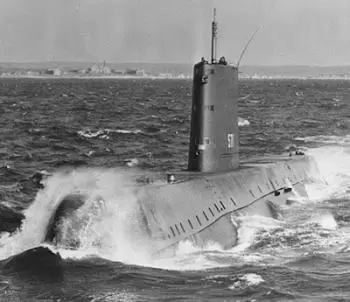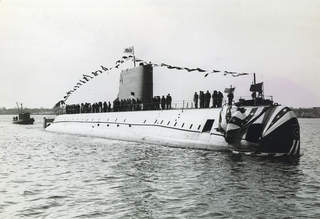
The first nuclear-powered submarine was the USS Nautilus (SSN-571), which was launched on January 21, 1954. It was an important milestone in the history of naval technology and nuclear power.
The USS Nautilus used a nuclear reactor to generate thermal power, which in turn drove a turbine to generate mechanical power and propel the ship.
This submarine did not depend on external supplies of air to function, which allowed it to remain submerged for long periods of time and to travel greater distances compared to conventional submarines.
The success of the USS Nautilus paved the way for the development of more advanced and sophisticated nuclear powered submarines around the world. Nuclear propulsion technology not only improved the range and efficiency of submarines, but also had a significant impact on naval strategy and geopolitics.
Advantages compared to diesel submarines
Until now, submarines generated electrical power using diesel engines. This energy could be stored in batteries and later used to power the electric motors once submerged. As diesel engines need oxygen to carry out the combustion of the fuel, it forced the submarines to surface periodically.
In times of war this was a great disadvantage because on the surface the submarines are very vulnerable and the engines produce a lot of noise that makes them easily detectable.
Origin and construction
Hyman Rickover was a young captain in the US Navy. He studied nuclear physics and, motivated by his compatriot Philip Albelson, realized the potential that nuclear energy could have to power a nuclear submarine using a small nuclear reactor.
Initially, Rickover did not have the support of his superiors who, seeing that the existing nuclear reactors occupied a couple of hectares on the ground, did not see the possibility of putting it inside a submarine. However, Rickover managed to become the head of the Nuclear Power Division of the Navy Office of Ships and - at the same time - head of the naval reactor branch of the Atomic Energy Commission.
Nautilus project
These charges allowed him to launch his project and in January 1954 the world's first nuclear-powered submarine was built.
They named it "Nautilus" as a tribute to Jules Verne, the author of "20,000 Leagues Under the Sea." A year later, with hull number SSN-571 painted in white, she was launched and sailed for the first time.
Characteristics of the Nautilus nuclear submarine
The main characteristics of the Nautilus nuclear submarine are the following:
The physical characteristics of the USS Nautilus are as follows:
-
Length: The USS Nautilus had a total length of approximately 98 meters (320 feet).
-
Width: The maximum width of the submarine was around 8.2 meters (27 feet).
-
Displacement: The surface displacement of the Nautilus was around 3,530 tons. In immersion, the displacement varied due to the density of the water and other factors.
-
Crew: The crew of the Nautilus consisted of around 13 officers and 92 ratings.
-
Operating Depth: The Nautilus was designed to operate at significantly greater depths than conventional submarines. It could reach depths greater than 100 meters (approximately 300 feet).
-
Armament: The Nautilus' armament included 6 torpedo tubes, allowing it to participate in offensive and defensive operations.
-
Propulsion system: The nuclear propulsion system was composed of a pressurized water nuclear reactor (PWR) that generated thermal energy, which was converted into mechanical energy to drive the turbine and propel the submarine.
Nautilus records and achievements
USS Nautilus set several notable records and achievements throughout her career. In addition to being the first nuclear powered submarine, some of the most prominent include:
First submarine North Pole crossing
In 1958, the Nautilus became the first submarine to cross the North Pole underwater in Operation Sunshine. She made the historic journey under the polar ice, demonstrating the ability of nuclear propulsion to operate in extreme conditions and under ice sheets.
The submarine set sail from Pearl Harbor for the Pole with 116 men on board (including four scientists specially chosen for this trip) and commanded by William Anderson.
The Nautilus nuclear submarine would travel more than 1,000 miles below the Arctic ice cap to reach the North Pole. After passing through the Bering Strait, the submarine submerged to 150 meters and began sailing under a layer of between 3 and 15 meters of solid ice until it was able to cross from the Pacific Ocean to the Atlantic Ocean.
Strategically it was very important for the US because it crossed the Atlantic for the first time by a different route than the Panama Canal or Cape Horn.
The construction of the first nuclear-powered submarine had made it possible to use the route from the Bering Strait to Greenland under the ice.
Speed and distance record
The Nautilus set speed and distance records for submarines in its day. On her journey under the polar ice, she reached speeds of up to 25 knots and covered more than 1,800 nautical miles in 90 hours.
Long duration operations
Thanks to its nuclear propulsion, the Nautilus had the ability to operate for months without the need for refueling or air. This allowed it to fly extended missions and maintain a constant presence on the high seas.
In 1957 he achieved his first great feat: living up to his name, the Nautilus nuclear submarine managed to travel submerged 60,000 nautical miles, a distance equal to the 20,000 leagues (or 111,100 kilometers) of the title of Jules Verne's famous novel Nautilus.
Test of technology and tactical concepts
The Nautilus was used to test and demonstrate new underwater technology and tactics. Its success and versatility influenced the evolution of naval strategy and the development of future submarines.
Influence on the development of nuclear submarines
The successful operation of the Nautilus influenced the development of nuclear submarines around the world. His design and achievements laid the foundation for the construction of more advanced and capable nuclear-powered submarines.
Contribution to the Cold War
During the Cold War, the Nautilus played an important role in providing the United States with a technological advantage in terms of submarine capability. Its nuclear propulsion technology and the achievements of it strengthened the strategic position of the United States Navy.
What finally happened to the Nautilus?
Of course, a few years later the Russians would develop their own nuclear submarines and the Cold War scales would once again balance, forcing both sides to continue developing new technologies.
The Nautilus nuclear submarine was in service for 25 years. Later it became a museum moored at the Naval Submarine Base New London in the city of Groton (Connecticut), and receives more than 250,000 visitors each year.